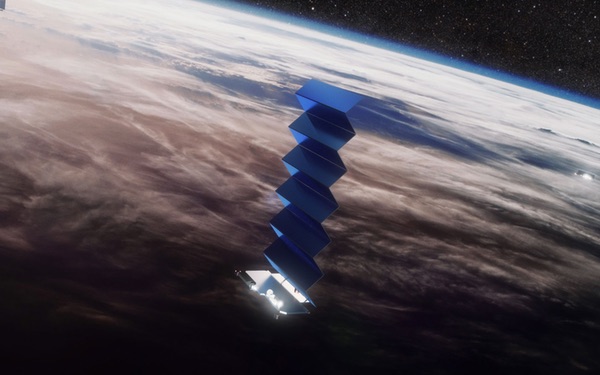The promise and challenges of Starlinkby Namrata Goswami
|
| Starlink specifically is a boon to the world because it will offer global broadband, providing extreme low-latency communications important to key economic sectors such as finance. |
Starlink is Elon Musk’s ambitious project to provide satellite based broadband services to the world starting as soon as 2020. For Starlink to be effective, it will require a mega-constellation of as many as 42,000 satellites, based on regulatory filings. Starlink is aimed at a global market, especially remote areas where terrestrial alternatives are limited. Satellite Internet will provide major relief to people in remote areas, with no Internet access due to their distance from wired networks. In 2015, while travelling in a remote area near the India-Tibet border, I had no Internet access for days on end.
Satellite Internet should break government owned expensive microwave cell towers and optical fiber-based geographically grounded Internet monopolies, democratizing space communications. It will break open human potential, empowering individuals and communities, currently limited by corrupt and incompetent government telecommunication systems in many parts of our globe. Not many of us who already have easy access to the Internet realize that this is not a reality for many remote areas of the world. Connecting the other three billion will be a huge economic benefit to global wealth and equity.
Starlink specifically is a boon to the world because it will offer global broadband, providing extreme low-latency communications important to key economic sectors such as finance. Satellite constellations in general—not just Starlink—are a boon to humanity, enabling a safer, more connected, more secure world due to better Earth observation, timing, navigation, and communication. More importantly, it will connect many ignored and remote communities, and provides an alternative to connecting via an authoritarian-controlled 5G provider like Huawei.
Despite these potential benefits for humankind, having mega-satellite constellations in low Earth orbit is a problem for many astronomers. With thousands of artificial satellites crisscrossing the night sky, astronomers worry that their observations of everything from asteroids to distant galaxies, dependent on very dark skies, will be forever impeded by light pollution from thousands of satellites.
So, what can be done to mitigate the concerns of astronomers while, at the same time, offer the much needed Internet relief to those who simply do not have reliable access today? Starlink does create urgency for some key innovations in space traffic control and astronomy-friendly satellites. One solution is to create satellites that are less optically reflective at dusk to interfere less in astronomy.
| Given the reality that thousands of satellites will be launched in the coming decade, by not just SpaceX but also others like OneWeb, and by countries like China, it is critical we adapt fast and take advantage of the opportunities this future provides us, while simultaneously constituting the required regulatory framework. |
But astronomers may not be thinking creatively enough: a very large satellite constellation offers interesting possibilities for them. Astronomers can observe stars during known satellite transits or occultation that may offer new techniques, as has been demonstrated in exoplanet finding techniques. Starlink may offer the astronomy community affordable opportunities to improve Earth-bound astronomy. Starlink satellites might be able to host instrumentation to help fine-tune telescopes. Satellites might even host artificial laser guide-stars to help adaptive optics. Moreover, Starlink itself may offer opportunities for in-space astronomy with hosted payloads of astronomy instruments. Laser crosslinks could enable many small telescopes on several satellites to act as one giant telescope using a technique called interferometry.
The high volume of launches of SpaceX’s Starship launch vehicle means even greater opportunities and lower costs for in-space astronomy. The expected pace of launch to deploy and constantly replenish Starlink should offer astronomers rideshare opportunities to send telescopes to space frequently. Astronomers have not yet adapted to the low cost of access provided by Falcon 9 and Falcon Heavy. Since Starlink is a driver for Starship, the ability of Starship to launch 100 metric tons to orbit offers astronomers amazing possibilities to affordably launch telescopes many times larger than Hubble or James Webb. With Starship’s ability to refuel, it could place them in great locations for astronomy, such as Earth-Moon L2 or Sun-Earth L2, or a Venus-like orbit.
As satellite traffic density goes up, we can expect to see similar innovations as we saw in high-density air traffic: it will become mandatory in highly desirable low earth orbits to offer precision navigation and maneuver capabilities (performance-based navigation), transponders that identify satellite location, and traffic collision avoidance systems where satellites communicate with others on a collision course and take evasive action on their own. We could see innovations to global rules for debris deorbit and salvage. This could all be a good thing as human capability to get to space only gets cheaper. Given the reality that thousands of satellites will be launched in the coming decade, by not just SpaceX, but others like OneWeb, and countries like China, it is critical we adapt fast and take advantage of the opportunities this future provides us, while simultaneously constituting the required regulatory framework.
Note: we are temporarily moderating all comments submitted to deal with a surge in spam.
